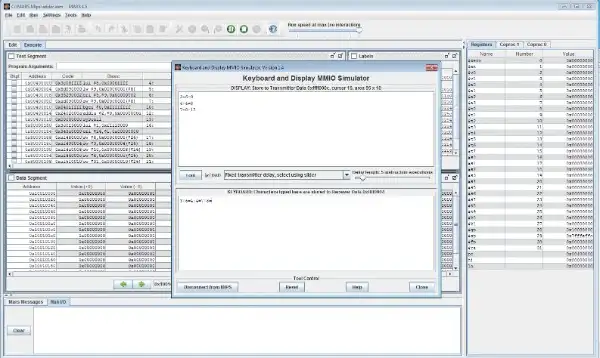The assignment deals with the implementation of a single-digit adder in MIPS assembly. The program uses the MMIO capabilities of the MARS simulator in order to read the inputs from the user. The program runs in a loop that reads the characters and calculates the result of the operation. Here is the solution to this task provided by our MIPS assembly homework help doers.
Creating a Single-Digit Adder using the MMIO Capabilities of MARS Simulator

Source Code
.text
.globl main
main:
lui $t0,0xffff # load address of receiver control
lw $t1,0($t0) # load receiver control state
ori $t1,$t1,2 # enable keyboard interrupts
sw $t1,0($t0) # save receiver control state
loop:
b loop
li $v0, 10 # exit the program
syscall
.ktext 0x80000180 # location of exception/interrupt handler
la $k0,regspace
sw $t0,($k0) # save t0 value
sw $t1,4($k0) # save t1 value
sw $t2,8($k0) # save t2 value
sw $a0,12($k0) # save a0 value
sw $ra,16($k0) # save ra value
mfc0 $k0,$13 # load the cause register in k0
srl $t0,$k0, 2 # Extract exception code from $k0, bits 2-5
andi $t0,$t0, 0x1f
bnez $t0,skip # if not zero is not an interrupt
lui $t0,0xffff # load start address of I/O registers
lw $a0,4($t0) # load received character
la $t0,state
lw $t1,($t0) # load current state
beq $t1,0,state0
beq $t1,1,state1
beq $t1,2,state2
beq $t1,3,state3
state0:
blt $a0,'0',error # see if the char was a digit
bgt $a0,'9',error # if not, print error
li $t1,1 # go to state 1
sw $t1,($t0) # save state
la $t0,z
addi $t1,$a0,-48 # convert ascii to integer
sw $t1,($t0) # update total sum
b print # print current char
state1:
bne $a0,'+',error # see if the char was a plus sign, if not, print error
li $t1,2 # go to state 2
sw $t1,($t0) # save state
b print # print current char
state2:
blt $a0,'0',error # see if the char was a digit
bgt $a0,'9',error # if not, print error
li $t1,3 # go to state 3
sw $t1,($t0) # save state
la $t0,z
lw $t1,($t0) # load current sum
addi $t2,$a0,-48 # convert ascii to integer
add $t1,$t1,$t2 # add digit
sw $t1,($t0) # update total sum
b print # print current char
state3:
bne $a0,'=',error # see if the char was a plus sign, if not, print error
li $t1,0 # go to state 0 to start over
sw $t1,($t0) # save state
jal print_char # print equal sign
la $t0,z
lw $t1,($t0) # load current sum
blt $t1,10,onedig # if it's only one digit, print it
addi $t2,$t1,-10 # calculate remaining digit
li $a0,'1' # print first a one
jal print_char
move $t1,$t2
onedig:
addi $a0,$t1,48 # convert to ascii
jal print_char # print sum
li $a0,10 # to print a new line
b print
error:
li $t1,0 # go to state 0
sw $t1,($t0) # save state
li $a0,10 # to print a new line
jal print_char
li $a0,'E' # indicate error
jal print_char
li $a0,'R' # indicate error
jal print_char
li $a0,'R' # indicate error
jal print_char
li $a0,10 # to print a new line
print:
jal print_char
skip:
la $k0,regspace
lw $t0,($k0) # restore t0 value
lw $t1,4($k0) # restore t1 value
lw $t2,8($k0) # restore t2 value
lw $a0,12($k0) # restore a0 value
lw $ra,16($k0) # restore ra value
eret # return from exception
# print the character in a0
print_char:
lui $t0,0xffff # load start address of I/O registers
wait:
lw $t1,8($t0) # poll terminal status
andi $t1,$t1,1 # see if it's ready to transmit
beq $t1,$0,wait # if not, keep polling
sw $a0,12($t0) # send character to display
jr $ra
.kdata
regspace: .space 20 # space to save 5 registers
state: .word 0
z: .byte 0
Related Samples
At ProgrammingHomeworkHelp.com, we offer specialized support for Assembly Language assignments, providing students with high-quality, expertly crafted samples. Our dedicated team ensures that each sample demonstrates key concepts and techniques relevant to Assembly Language programming. Whether you're struggling with code optimization, understanding low-level operations, or tackling complex assembly problems, our resources are designed to guide you through every step. With our comprehensive support and detailed samples, you'll gain a deeper understanding and achieve better results in your Assembly Language coursework. Visit us today for tailored help and expert guidance.
Assembly Language
Assembly Language
Assembly Language
Assembly Language
Assembly Language
Assembly Language
Assembly Language
Assembly Language
Assembly Language
Assembly Language
Assembly Language
Assembly Language
Assembly Language
Assembly Language
Assembly Language
Assembly Language
Assembly Language
Assembly Language
Assembly Language
Assembly Language
